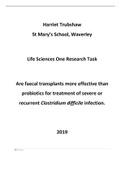Harriet Trubshaw
St Mary’s School, Waverley
Life Sciences One Research Task
Are faecal transplants more effective than
probiotics for treatment of severe or
recurrent Clostridium difficile infection.
2019
i|Page
,Table of Contents
List of Tables ............................................................................................................................. ii
List of Abbreviations ................................................................................................................ ii
1. Introduction ......................................................................................................................... 1
1.1. Aim and scope of the research..................................................................................... 1
1.2. Context/rationale of the research ................................................................................. 3
2. Literature Review ................................................................................................................ 4
2.1. Introduction .................................................................................................................. 4
2.2. Source 1: ..................................................................................................................... 4
Surawicz, C. M., Brandt, L. J., Binion, D. G., Ananthakrishnan, A. N., Curry, S. R., Gilligan, P.
H. et al. (2013). Guidelines for Diagnosis, Treatment, and Prevention of Clostridium difficile
Infections. The American Journal of Gastroenterology. 108:478-498 doi: 10.1038/ajg.2013.4 4
2.3. Source 2: ..................................................................................................................... 8
Mergenhagen, K.A., Wojciechowski, A. L., & Paladino, J.A. (2014). A Review of the
Economics of Treating Clostridium difficile Infection. PharmacoEconomics 32: 639-650. Doi:
10.1007/s40273-014-0161-y................................................................................................... 8
2.4. Source 3: ....................................................................................................................11
Na, X., & Kelly, C. (2011). Probiotics in Clostridium difficile Infection.J Clin Gastroenterol. 45
(Suppl):S154-S158. Doi:10.197/MCG.0b013e31822ec787....................................................11
2.5. Source 4: ....................................................................................................................15
Plummer, S., Weaver, M. A., Harris, J. C., Dee, P., & Hunter, J. (2004). Clostridium difficile
pilot study: effects of probiotic supplementation on the incidence of C. difficile diarrhoea.
International Microbiology, 7 :59-62. ......................................................................................15
2.6. Source 5: ....................................................................................................................17
McFarland, L. V. (2006). Meta-Analysis of Probiotics for the Prevention of Antibiotic
Associated Diarrhea and the Treatment of Clostridium difficile Disease. American Journal of
Gastroenterology. 812-822. Doi : 10.1111/j.1572-0241.2006.00465.x ...................................17
3. Discussion .........................................................................................................................20
3.1. Probiotics as treatment for diarrhoea and CDI ............................................................20
3.2. Faecal transplants as treatment for diarrhoea and CDI ...............................................24
4. Conclusion .........................................................................................................................29
4.1. Overall findings ...........................................................................................................29
4.2. Limitations ..................................................................................................................29
4.3. Recommendations ......................................................................................................30
4.4. Improvements .............................................................................................................30
5. Reflection ...........................................................................................................................31
6. References ........................................................................................................................32
7.
i|Page
,List of Tables
Table 1: Similarities in explanation, cause and treatment findings of three
sources................................................................................................................. Page 14
Table 2: Comparison of results of the efficacy of different strains of
probiotics in control trials ..................................................................................... Page 22
Table 3: The effectiveness of different strains of probiotics in preventing
and shortening diarrhoea .................................................................................... Page 23
Table 4: The effectiveness of faecal microbiota transplants in treating
diarrhoea associated with antibiotics or Clostridium difficile infection ................. Page 25
Table 5: Comparison between the success rate of different forms of
treatment of recurrent Clostridium difficile infection ............................................. Page 26
Table 6: Comparison between the success rates of various forms of
treatment for Clostridium difficile associated diarrhoea ....................................... Page 26
List of Abbreviations
AAD antibiotic associated diarrhoea
CDI Clostridium difficile infection
PhD Doctor of Philosophy
ii | P a g e
, 1. Introduction
1.1. Aim and scope of the research
The focus of this research task was to consider the most effective treatment of Clostridium
difficile infection (CDI). Clostridium difficile infection is deemed to be a serious health
concern as it can spread rapidly, causing severe health problems, some of which can be
life-threatening. In 2015 Clostridium difficile bacteria caused half a million infections,
which resulted in 15 000 deaths (Felman, 2019). While there are several possible types
of treatment for CDI, the known forms of treatment are not always effective and therefore
new forms of reliable and effective treatment need to be found. The objective of this
research task was to therefore establish if faecal transplants are more effective than
probiotics in treating severe or recurrent Clostridium difficile infection.
Clostridium difficile is a spore-forming, toxin-producing, gram-positive anaerobic
bacterium, which is abundant in soils and water (Norén, 2019) as well as in processed
meats and, human or animal faeces (Rupnik et al., 1997). Due to Clostridium difficile’s
ability to form spore, it has also proliferated in environments where most other bacteria
cannot survive. This is especially problematic in hospitals where the cleaning agents kill
most other bacteria, allowing C. difficile to multiple, and where it can be found on surfaces
such as taps, bed rails, stethoscopes and television remotes (Mayo Clinic, n.d.). It has, in
fact, become one of the most common hospital-acquired infections (Czepiel, 2019). Once
the spores enter the body, they can become pathogens that will cause the C. difficile
infection (Centers for Disease Control and Prevention, 2019).
The gut microbiome plays an important role in human health, where it strengthens and
protects the gut (Thursby & Juge, 2017) and aids the immune system by controlling and
responding to infections (Rooks, Garrett, 2017). Clostridium difficile is usually found as
part of the commensal microbiota in the human gastrointestinal tract (Tonna & Welsby,
2005). Although Clostridium difficile is usually commensal, when the microbiome is
disturbed, such as with the prolonged intake of antibiotics, the Clostridium difficile
1|Page




